Retro is in; retro is cool. If a motorcycle looks old and works like a modern one, you can have the best of both worlds. A nostalgic appearance is pleasing to young and old, and the rider enjoys classic style, sound and feel, with brakes that stop and no oil puddles on the ground. Among the U.S. manufacturers, no one answers the retro call better than Harley-Davidson, with choppers, bobbers and everything in between. Among the Europeans, quite rightly, it’s Triumph.
It started with the reintroduction of the Bonneville in 2001, a 790cc tribute to the original high-performance Triumph parallel twin with contemporary power and reliability. A couple of years later the new Bonnie was joined by the Thruxton café racer, a bow to the racing circuit where Triumph won 1st, 2nd and 3rd in 1969’s all-important Thruxton 500. This 2003 model was a fitting showcase for a refined, larger 865cc engine for the entire line. Then cruiser versions appeared, inspired by the parallel-twin choppers born in Europe that were popular here in the ’60s and ’70s. Most recently the 865cc twin family was joined by the Scrambler, complete with high pipes and knobby tires.
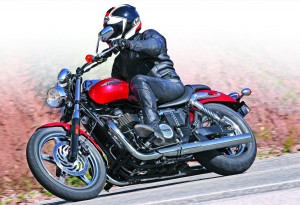
Which is your favorite? Mine is the Thruxton. Despite its flat tubular handlebar and high rearset pegs, the Thruxton fits me just right at speed, when the wind blast takes the pressure off my wrists and my weight is evenly distributed among hands, seat and feet. And I like the look of café racers, especially when there’s a single cylinder or parallel twin with polished covers under the tank. The Thruxton is the only factory production café racer or “clubman” to come along (to the U.S. anyway) with one or the other engine since the 1989 Honda GB500.
While it’s just right for a morning blast in the local canyons, the Thruxton’s café crouch can get tiring by lunchtime. What if you could pull-off a Transformer-like trick, flip a switch and turn the Thruxton into a relaxing cruiser for the afternoon, with a seating position like a lounge chair and custom looks to match? It would be just right for a lazy ride after lunch, when strafing corners seems less important than comfortably soaking up the scenery. Such a metamorphosis would have to retain the same basic engine—there are rules, you know—though some mechanical changes would be allowed to better conform it to cruising.
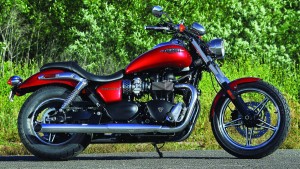
We are describing, of course, one of Triumph’s parallel-twin engined cruisers, in this case the hot-rod Speedmaster with its shorty fenders and cast wheels. At its heart is the same air-cooled, 865cc DOHC parallel twin with four valves per cylinder found in the Thruxton. It also has electronic fuel injection and a pair of throttle bodies that are very cleverly disguised as CV carburetors for a classic look. A 5-speed transmission and chain final drive are found on both bikes, too.
What about those tuning differences? You’ll recall the four-stroke engine cycle of intake, compression, power, exhaust (a.k.a. suck, squeeze, bang, blow). A 360-degree crankshaft like the Thruxton’s moves the pistons up-and-down together but fires them 180 degrees apart, giving the engine an even bang-bang-bang-bang pulse and a high-revving, fairly smooth power delivery that’s right for a sportbike.
The Speedmaster gets its more cruiserish rumble from a 270-degree crankshaft, firing the second cylinder just 90 degrees after the first, so that its pulses are more like bang-bang…bang-bang…bang-bang, etc. Though it has the same bore and stroke, its lower compression, milder cams, slash-cut mufflers instead of megaphones, and ignition and EFI changes increase the Speedmaster’s midrange torque but lower its top-end horsepower, and its redline to 8,000 rpm (from 8,500 in the Thruxton). While the Speedmaster still revs, feels and sounds more like a parallel twin than the traditional cruiser V-twin, its pulsing rumble and throatier exhaust make riding it quite a different experience from piloting the sporty, more urgent Thruxton.
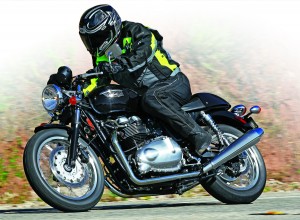
Climb aboard the café racer and point it toward the canyons. Boot heels hang on the footpegs and allow my 29-inch legs to relax despite the high rearward position of my feet, though the longer-legged may find it cramped. Around town and at stops the hard, low grips put an uncomfortable amount of weight on the wrists, but this goes away as the speed climbs and the wind pushes against you. If you find the de rigueur thin and uncomfortable solo-look seat is the only thing stopping you from taking seriously long rides, consider the optional gel seat on the accessories list along with a centerstand, classic-looking rubber knee pads and fork gaiters.
Potrero Road, Westlake Blvd., Decker—on a weekend these California canyon roads would be teaming with other riders, but this morning my only company are bicycles and the occasional car, and the Thruxton makes short work of them. Strong, usable power is on tap from 3,000 rpm nearly to redline, and the engine accelerates well enough that in these tight canyons you can leave it in 2nd or 3rd gear most of the time. While a peak of 54 horsepower at the rear wheel of a 500-pound bike is hardly neck-snapping, I’ve always found it more fun to ride a slower bike fast than a fast bike slow. It’s all about being in the right gear at the corner exit, and the Thruxton’s generous cornering clearance, quick but smooth steering and easy shifting help make that a snap.
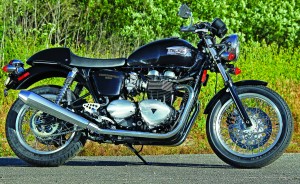
The Kayaba suspension on the Thruxton is simple but effective on the street up to my weight of 210 pounds or so; for the racetrack and/or heavier riders, some stiffer springs and better shocks should be near the top of your list. On such soft fork springs, the inch or so of adjustable preload makes little difference. The stock ride is compliant and comfortable, and the bike only gets out of shape over big bumps in corners.
Braking is similar in function in that the single discs at each end work well for normal to brisk street use, but the seriously wannagofast will need to improve the stopping power up front. Feel at the adjustable lever and pedal are linear and strong and they’re both easy to modulate. The single change that would reap the most benefits would be tires, as the stock bias-ply Metzeler Lasertec up front is probably there more for its correct looks than performance (that tread pattern has been around almost as long as CV carburetors). You’re still stuck running tubes in them, but spoked wheels are just as important to a café racer’s looks as those slick bar-end mirrors (that reflect somewhat fuzzy images but work well enough).
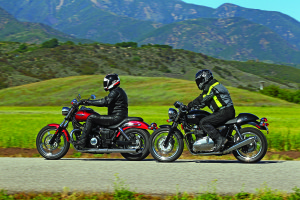
The ride drops me through turn after turn in the warm inland canyons, down Decker Road to the cool Pacific Coast Highway. Stopping for a sub sandwich near the office about an hour later, a guy asks me, “Isn’t that one of those retro bikes?” and spends a few minutes reminiscing about his motorcycling youth while I write down the make and model of the bike for him. Reaching the office, there’s some time to eat and delete email, and then it’s the Speedmaster’s turn for a ride. Ahh, the wide, low seat feels like a couch compared to the Thruxton’s businesslike perch, and my tired arms hang comfortably from the high, wide handlebar. Footpegs are a nice stretch forward—not as far as some cruisers so I can easily reach them with my feet, but it still feels like sitting in a recliner. Heading north from the office the ocean on my left is crystal blue and the nip in the air is held at bay by the warm sun. The Speedmaster and I lope along Old Rincon Highway, past Faria Beach, the polo grounds in Santa Barbara and up Cabrillo Blvd. past the pier and beach volleyball courts, where its classic cruiser looks turn more heads among the locals and tourists than the enthusiast-oriented Thruxton ever will.
At this slower pace I find myself able to enjoy the scenery more, tucking into side roads I haven’t ridden since my college days in Santa Barbara and staring in awe at the mansions and landscaping in Hope Ranch. Power is still readily available with a throaty rumble, but it drops off much earlier so there’s little point in racing between stoplights (or cafés). At this cruiserish pace everything works fine on the Speedmaster, though its rear shocks are a bit harsh and can kick the rider out of the seat over sharp bumps. The cruiser is even smoother than the café racer, which buzzes the grips and footpegs from 4,500 rpm and up. Fortunately it stays under that at highway cruising speed. On the Speedmaster buzzy vibration is never an issue anywhere in the powerband, with just a pleasant pulse feel reaching the rider.
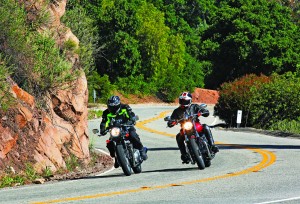
Highway 101 takes the Speedmaster and me south toward home again, but first there’s Highway 150 and some corners to tackle. Surprisingly, I’m able to stay with a sports car making good time on the twists and turns around Lake Casitas, barely skimming the fold-up footpegs on the asphalt at times. The tubeless Metzeler ME880 tires front and rear offer plenty of performance and should last a long time. Once again a better pair of shocks and fork springs would up the Speedmaster’s game quite well for a heavier or faster rider, but for this lazy afternoon loop I found it quite willing and able. A windscreen would make a fine addition for touring, and Triumph offers several along with saddlebags, touring and solo seats and lots of chrome bolt-ons.
Not surprisingly the Triumph Speedmaster and Thruxton share a few traits and features. Shifting is buttery smooth, though their low-effort clutches don’t engage until the adjustable levers are almost fully released. The higher seat of the Thruxton is so narrow, it’s nearly as easy to reach the ground on it as on the low Speedmaster. Both have bolt-on seats and no storage to speak of, and both run on regular fuel, though the Thruxton has a smaller tank and burns it at a faster rate. Instrumentation is complete, with tachometers, clocks and dual tripmeters. Both also have manual fast-idle controls (only needed in cooler weather), oil coolers and require separate keys for their steering locks. As is Triumph’s habit on its classics neither comes with a locking gas cap, though they are accessories. The Thruxton’s sporty rear seat cowl is easily removed and the bike has passenger footpegs, but I wouldn’t plan on long two-up rides with a passenger on either of the minimalist stock pillions.
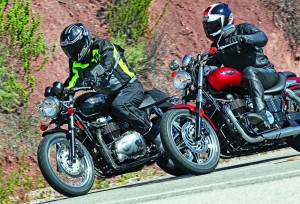
Cruiser or café racer? It’s really hard to say. Both work really well for their intended purposes, with good fuel economy, lots of fun and low entry costs under $8,800. While we can’t actually transform one bike into another, there’s no reason you can’t have both like we did. Right now our biggest problem is figuring out which one to keep for a long-term test….
2012 Triumph Speedmaster/Thruxton
Base Price: $8,299 / $8,799
Warranty: 2 yrs., unltd. miles
Website: triumphmotorcycles.com
Engine
Type: Air-cooled, transverse parallel twin
Displacement: 865cc
Bore x Stroke: 90.0 x 68.0mm
Compression Ratio: 9.2:1 / 9.9:1
Valve Train: DOHC, 4 valves per cyl.
Valve Adj. Interval: 12,000 miles
Fuel Delivery: Multipoint sequential EFI w/ secondary air injection
Lubrication System: Wet sump,
4.75-qt. cap.
Transmission: 5-speed, cable-
actuated wet clutch
Final Drive: X-ring chain
Electrical
Ignition: Digital electronic
Charging Output: 312 watts max.
Battery: 12V 10AH
Chassis
Frame: Tubular-steel double cradle, box-section steel swingarm
Wheelbase: 63.2 / 58.6 in.
Rake/Trail: 33.8/27.0 degrees / 6.7/3.9 in.
Seat Height: 27.1 / 32.3 in.
Suspension, Front: Kayaba 41mm w/ 4.7 in. travel / Thruxton w/ adj. preload
Rear: Kayaba dual shocks w/ adj. preload & 3.8 / 4.2 in. travel
Brakes, Front: Single 310 / 320mm floating disc w/ Nissin 2-piston pin-slide caliper
Rear: Single 285 / 255mm disc w/ Nissin 2-piston pin-slide caliper
Wheels, Front: Cast, 2.5 x 19 / Spoked, 2.5 x 18 in.
Rear: Cast, 4.0 x 15 / Spoked, 3.5 x 17 in.
Tires, Front: 100/90-H19 / 100/90-H18
Rear: 170/80-H15 / 130/80-HR17
Wet Weight: 568 / 506 lbs.
Load Capacity: 422 / 440 lbs.
GVWR: 990 / 946 lbs.
Performance
Fuel Capacity: 5.1 / 4.2 gals.
MPG: 87 PON min. (low/avg/high) Speedmaster: 41.0/44.5/48.0
Thruxton: 38.9/40.8/42.8
Estimated Range: 227 / 171 miles
Indicated RPM at 60 MPH: 3,300 / 3,500
(This Rider Comparison: Fraternal Twins was published in the August 2012 issue of Rider.)

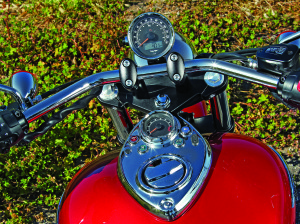
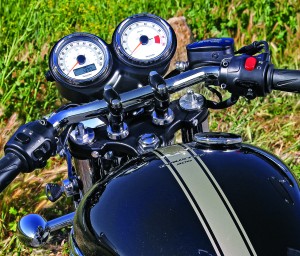
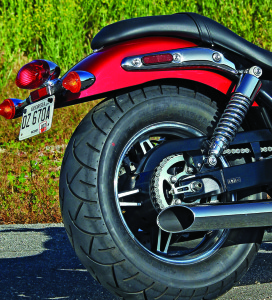
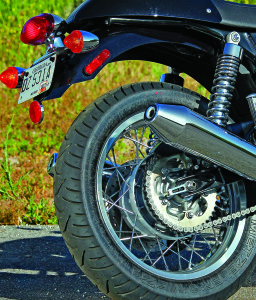
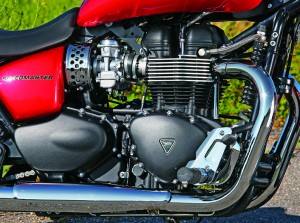
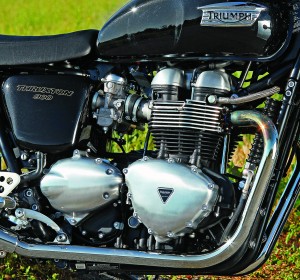







i realy like the two bikes i am a new rider and want a old school bike with the new tech in it. which out of the two would you say is better i want a bike that is fast but not to slow that i will grwo out of it in 3 mounths and i dont want a bike that icant handle and will kill my self on